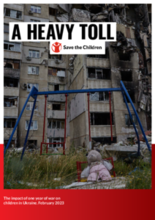The dramatic escalation of war in Ukraine in February 2022 has affected every person in the country.
In the year since February 2022, at least 18,657 civilian casualties have been verified by the UN: 7,110 killed and 11,547 injured. The true figures are likely significantly higher. In Ukraine, those who are hit hardest are those who are least responsible — the country’s children. More than 4 children a day are killed or injured, and this number is assumed to be a gross underestimate. Reports of sexual violence, killing, torture and other degrading treatment of children continue to emerge, with very little regard to International Humanitarian Law and International Human Rights Law. At least 17.7 million people, including 4.1 million children, are in need of humanitarian assistance —around 45 per cent of the pre-February 24 population in Ukraine, and triggered an unprecedent wave of displacement both inside Ukraine and to other countries in Europe. By January 2023, 6.2 million Ukrainians remain internally displaced, and some 8 million are refugees in neighbouring and other countries. Mines and unexploded ordnance are also a deadly risk for over 2 million children.
Over 250,000 explosive remnants of war have already been removed and destroyed since March 2022, but millions more remain, with explosive ordnance potentially present in all areas affected by the war. Towards the end of 2022, attacks on energy infrastructure intensified, forcing millions across the country to endure winter while rationing electricity and water. In areas that have recently seen active fighting, reports emerged of families melting snow and collecting water from puddles, or queuing for hours to receive basics like bread and drinking water just to survive.The fighting has forced school closures across the country, leaving children with online education as their only option. However, less than 30 per cent of children have access to an individual device in Ukraine. Frequent electricity cuts pose problems for children that do have devices. Many have missed years of education after years of conflict in the east, the COVID-19 lockdown and now active hostilities across the country.
Children have spent more than 900 hours hiding in bunkers across the country, with this number going significantly higher in areas closer to active hostilities. In total, the UN estimates that more than 3.5 million children in Ukraine live under severe to catastrophic levels of needs across the country. Children in non-government-controlled areas (NGCA), often close to conflict lines and with the least access to help, are amongst the most at risk. And the conditions for those who were vulnerable even prior to the escalation — such as the 100,000 children who were in institutional care — have been exacerbated either by the ongoing fighting or by being deprioritised both in policy and assistance.
One year of war has been a catastrophe for children in Ukraine. Children live with constant fear and with the psychological distress of having witnessed violence, separation from parents, family members and friends, fleeing across borders or seeing their loved ones killed. Too many are going without the assistance they need and all are at grave risk of harm. With no end to the war in sight, Save the Children is calling for needs of children, and their need to be protected, to be prioritised. For that to happen, the war must be conducted in line with international humanitarian law. The indiscriminate bombardment and targeting of civilian infrastructure – including schools – must come to an end. Those who are responsible for breaching these laws and violating children’s rights must be held to account.

